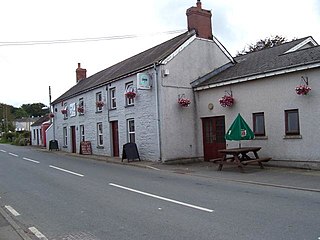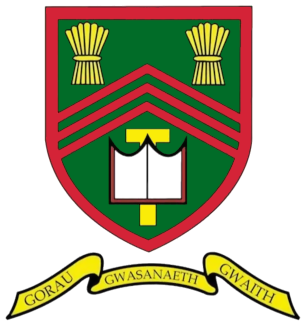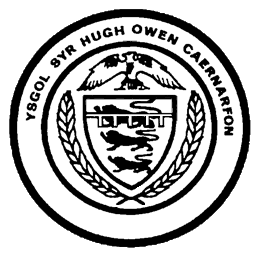This article provides an overview of education in Wales from early childhood to university and adult skills. Largely state funded and free-at-the-point-of-use at a primary and secondary level, education is compulsory for children in Wales aged five to sixteen years old. It differs to some extent in structure and content to other parts of the United Kingdom, in the later case particularly in relation to the teaching of the Welsh language.
The education system in Northern Ireland differs from elsewhere in the United Kingdom, but is similar to the Republic of Ireland in sharing in the development of the national school system and serving a similar society with a relatively rural population. A child's age on 1 July determines the point of entry into the relevant stage of education in the region, whereas the relevant date in England and Wales is 1 September.

Chirk is a town and community in Wrexham County Borough, Wales, 10 miles south of Wrexham, between it and Oswestry. At the 2011 census, it had a population of 4,468. Historically in the traditional county of Denbighshire, and later Clwyd, it has been part of Wrexham County Borough since a local government reorganisation in 1996. The border with the English county of Shropshire is immediately south of the town, on the other side of the River Ceiriog.

Talgarreg is a small village in the community of Llandysiliogogo, in the county of Ceredigion, Wales. The village is located on a junction of the B4459, approximately half way between New Quay and Llandysul.

Diwan is a federation of Breton-medium schools in Brittany.

Ysgol Llanhari is a Welsh-medium school for 3-19 year olds situated in the village of Llanharry, Rhondda Cynon Taf, Wales.

Ysgol Gyfun Gymraeg Glantaf is a Welsh-medium coeducational secondary school in Llandaff North, a district in the north of Cardiff, Wales; it is the largest of its kind in the country. Of the three Welsh-medium secondary schools serving Cardiff, it was the first to be established; the others are Ysgol Gyfun Gymraeg Plasmawr and Ysgol Gyfun Gymraeg Bro Edern. As of 2017, 36% of pupils came from Welsh-speaking homes.
Ysgol Bro Preseli is a Welsh 3-18 school in the village of Crymych, Pembrokeshire, Wales.

Ysgol Gyfun Llangefni is a bilingual community comprehensive school for pupils aged 11 to 18 years old located in Llangefni, Anglesey. Pupils come from the town of Llangefni and the surrounding villages and rural areas. The school opened in 1953 and currently has 686 students on roll.

Ysgol Syr Hugh Owen is a bilingual comprehensive secondary school for pupils aged 11–18. The school is situated in Caernarfon, Gwynedd, Wales. The school was established in 1894, the first to be built under the Welsh Intermediate Education Act 1889, which was heavily influenced by the educator Sir Hugh Owen, after whom the school was named.
Ysgol Penglais School is an 11–18 comprehensive school situated in the town of Aberystwyth, Ceredigion, West Wales. It offers education to approximately 1,100 pupils aged 11 to 18. The school was established in 1973 and teaches mainly through the medium of English.

Ysgol Tryfan is a bilingual comprehensive school for pupils aged 11–18, situated in Bangor, Gwynedd. 471 pupils were enrolled at the school in 2022.
Gwenllian Lansdown Davies is a former Welsh Plaid Cymru politician, a former County Councillor for Riverside, and Chief Executive of Plaid Cymru between 2007 and 2011. She is currently the Chief Executive of Mudiad Ysgolion Meithrin.
Ysgol Dyffryn Teifi was a bilingual comprehensive school in Llandysul, Ceredigion. It stood on the site of the previous Llandysul Grammar School. The school was established in 1984 following the re-organisation of education in the Teifi Valley. It was formerly a county school and grammar school dating back to the 19th century.
Mudiad Meithrin, formerly Mudiad Ysgolion Meithrin is a voluntary movement specialising in the provision of Welsh-medium early years education, including nursery groups. It aims to give every young child in Wales the opportunity to benefit from early years services and experiences through the medium of Welsh. These voluntary groups are often crucial in the subsequent establishment of a Welsh-medium primary school in the area. The movement is particularly active in Anglicised areas of Wales and has grown considerably since the 1970s. In 2011, the organisation's 40th birthday, it was renamed Mudiad Meithrin.

Ysgol Bro Gwaun is a secondary comprehensive school in the town of Fishguard in north Pembrokeshire. It is a predominantly English-medium school with significant use of Welsh, and has a catchment area covering the towns of Fishguard and Goodwick, the villages of Scleddau, Letterston and Newport and the surrounding areas including the Gwaun valley.

Llanfyllin High School was a bilingual secondary school situated in the mid-Wales town of Llanfyllin. As of its final Estyn inspection in February 2016, it had 824 pupils, down from 1,001 in 2009.

Ysgol Gymraeg Pwll Coch is a large Welsh-medium primary school in the Canton area of western Cardiff, in Wales.
Ysgol Bro Dinefwr is a bilingual secondary school for pupils aged 11–19 in Ffairfach, Carmarthenshire. As of 2023, the school had 1,175 pupils on roll, with 177 of those pupils in the sixth form.

The history of education in Wales spans from the period of Roman rule to the present day. Early forms of formal education were church or privately run and available to only a small segment of the population. In the 17th and 18th centuries significant efforts were made, mainly by charitable causes, to expand access to basic education. In the 19th century a state education system developed. By the end of the century, education had become free and compulsory for children aged 5 to 12 years. Further increases in the school leaving age and the development of a system of secondary schools led by the mid-20th century to universal secondary education—separate secondary schools for students of different academic abilities ended by 1980.












